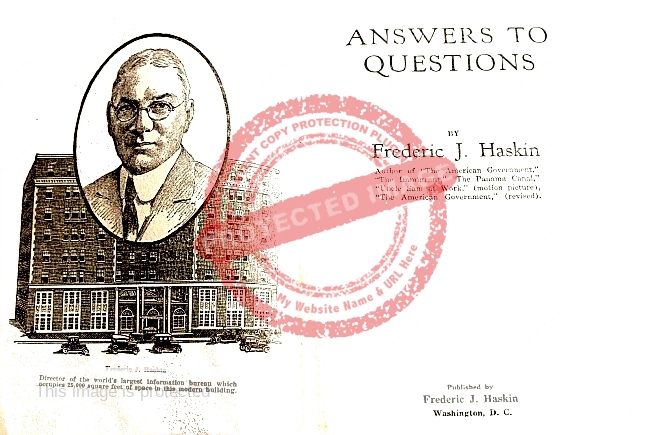Frederic Jennings Haskin was born 1873 in Shelbina, Missouri. With only the most rudimentary formal education, his first job, at the age of ten, was as housekeeper for a weekly publication called Torchlight. Many years later, Haskin became its publisher, and a correspondent with papers such as the St. Louis Globe Democrat and the Kansas City Star. In the course of his career, Haskin traveled very widely, reporting on the sights and sounds of places as diverse as the Yukon and Japan, though it is unknown whether or not he ever saw Lake Chapala with his own eyes.
Haskin wrote several books, including The American Government (1912); The Immigrant: an Asset and a Liability (1913); The Panama Canal (1913); 5000 New Answers To Questions (1933); and The American Government Today (1935). But he was best known for an information column that appeared in The Star and more than 100 other newspapers, where, aided by a team of researchers, he answered readers’ questions, more than 25 million in total according to some estimates.

So, how did Haskin describe Lake Chapala? In 1916 he wrote that it was:
a shallow and uncertain body of water, given to sudden bursts of wrath without warning, rising suddenly in storm under the whip of a squall, and making life miserable for the Mexican fishermen in their little open boats.
They are poor sailors, anyway, and their methods would awaken the contempt of a Gloucesterman, but they continue to fish in spite of the danger, contenting themselves with a preliminary prayer in their little village church, and in burning a candle for the souls of those whom the squalls have overtaken.
All round about Chapala lies what was one of the rich districts of Mexico under the old regime.”
Then, after a brief discussion of how the hacienda system meant that most of the land was controlled by only a small number of people, Haskin commented on the impact of the Revolution:
Much of that old-time life had been swept away in the storms of revolution. The shores of Chapala are changing, passing through a time of stress that may lead to better things than the picturesque feudalism of yesterday. But the restless lake that saw the coming of the Aztecs and the Mayas, that watched the Spaniards take the land and is watching them lose it back to the Indians is ever the same. Under the moon it whispers its old secret to the pebbled beaches.”
Haskin, a charter member of the US National Press Club and its third president in 1912, died at his home in Washington, DC on 24 April 1944.
Sources
- Frederic J Haskin. 1916. Buffalo Evening News, 27 Nov 1916.
- National Press Club Archives. Finding Aid for the Frederic J. Haskin Collection (1911-1969).
The 11 chapters of Lake Chapala: A Postcard History take a visual look at the lake’s past from many different perspectives.
Comments, corrections or additional material related to any of the writers and artists featured in our series of mini-bios are welcomed. Please use the comments feature at the bottom of individual posts, or email us.
Tony Burton’s books include “Lake Chapala: A Postcard History” (2022), “Foreign Footprints in Ajijic” (2022), “If Walls Could Talk: Chapala’s historic buildings and their former occupants” (2020), (available in translation as “Si Las Paredes Hablaran”), “Mexican Kaleidoscope” (2016), and “Lake Chapala Through the Ages” (2008).
What did the artist Jules Rubinstein present at the Lake Chapala?
Did you intend to add your comment to the post about Frederic Haskin? For more about Jules Rubinstein and his connection to Lake Chapala, see https://lakechapalaartists.com/?p=9050 and for more about his wife Abby Rubinstein, see https://lakechapalaartists.com/?p=9051.
Glad to have caught this—-